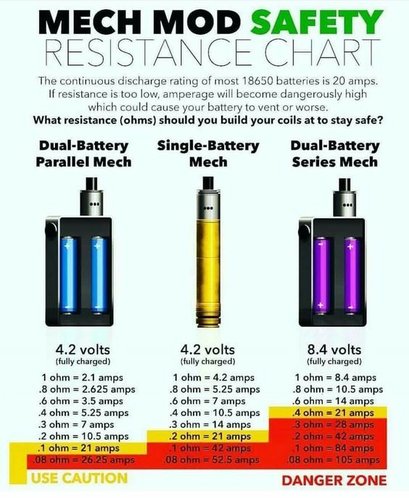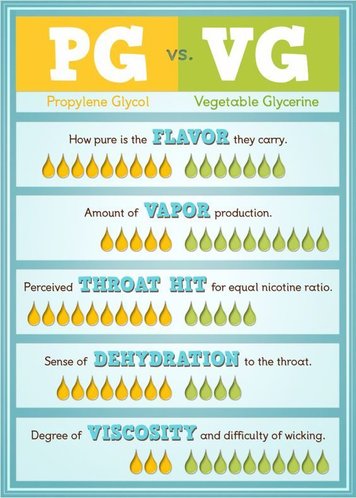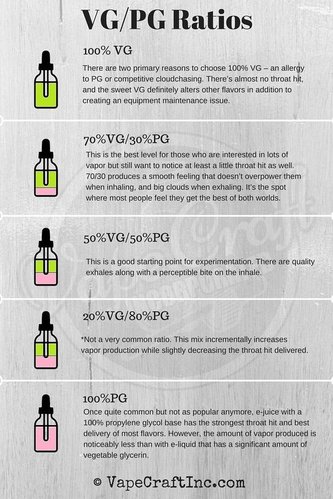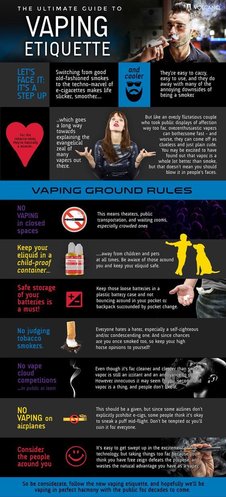"Mods" explained - how to pick what you need.
Posted by Bombies on October 12, 2015
If you’re new to the vaping community, you might be confused by all these different power delivering devices of varying shape and size. Some are massive boxes, some are thick tubes, some are little pens, and some are the size of a regular cigarette. What’s the difference? What’s the right choice? It’s certainly overwhelming if you’re coming at it from a spot of little knowledge on the topic. It certainly doesn’t help that there are new devices out nearly every week. Fortunately, we can categorize these devices - called “mods” - to make things easier.
“But, why is it called a mod?”
Good question, reader. It’s a term derived from the word “modification”. Back when vaping was still largely unheard of, if you wanted more power and performance from your device - you needed to make your own. Usually, people made these out of modified flashlight tubes. Generally speaking, these mods were nothing more than a simple circuit containing a battery, a switch, and a connection for the atomizer. No chip set regulating power or preventing user error. But, they did the job - and the term “mod” stuck itself into the vaping lexicon.
Breaking it down: the two types of mod
Broadly speaking, there are two types of mod: mechanical, and regulated. There are a number of sub-categories, but by and large you can categorize a mod by whether or not there is a chip inside that controls the power output. A mechanical mod is like those original mods - a simple circuit connecting the battery (or batteries) to the atomizer, with no major circuitry aside from a switch to complete the connection. These mods provide no protection to the user in terms of battery safety; it is entirely in the hands of the user to build coils within a safe resistance limit, ensure that their batteries are capable of handling the loads they require, and ensure that their builds are not shorting out. Regulated devices, from simple pens up to high powered boxes, offer a range of protections and even control over power output that mechanical mods can’t normally offer.
Regulated devices, the other option, have more complex inner workings that regulate the power being delivered to the atomizer and provide protections to the user from shorts, over-draining batteries, and excessive power draw (exceeding the amp load your battery is capable of handling). Regulated devices range from simple pen-style mods to larger box shaped mods that can deliver a ton of power.
Mech Mods
With mech mods, there are two common form factors, tubes, or boxes. Let’s take a look at how these work.
Regulated Mods
Regulated mods come in all shapes and sizes, and range in functionality from simple short-circuit protection, to full blown power control and even temperature control. They offer consistent performance and a level of user protection that mechanical mods don’t have, making vaping safer and more accessible. There are three classes of regulated mods, and several “sub classes,” so let’s take a look at them.
Cigalike
Cigalikes are either disposable, or refillable cigarette-sized vapes. They offer conveniently small sizes, trading battery life and liquid capacity for their size. These generally have very little user control, but offer some simple battery protections. Most of us started with a cigalike, and they’re good enough at what they do.
Pens, or “E-Gos”
Pens, E-Gos, whatever you may call them - these are the starter setup that most people have used. They’re small, about the size of a sharpie, and that’s their selling point. The most control you get out of one of these is the ability to control the voltage output of the battery, increasing flavor and vapor. They are dead simple, which is great for those who don’t want to be bothered with learning about watts and how they affect your vape - they’re cheap, easy, and portable.
SubOhm tubes
These are a newer class of mod in the regulated scene, like a heavily modified pen. They are larger, but offer significantly more power and can fire below 1.0 ohms. They’re somewhat more portable than boxes in terms of size, and can offer a sleek look with a 22mm tank or RDA on top. They’re for the person who kinda wants a mech, but doesn’t want to worry about batteries and lack of protection.
Box Mods
This is where things get more complicated. Box mods have a huge number of variations in terms of power output, feature sets, battery configuration, size, you name it. Let’s take a look at some of these features, since it’s almost impossible to categorize box mods in broad strokes.
Wattage Control
Almost all box mods these days offer wattage control. You simply set the wattage output you want, and the mod calculates the necessary voltage output for your atomizer’s resistance. This lets you fine tune your settings for a “perfect vape”. There is no set wattage that is definitively “the best”, so it stands to reason the users should be able to fine tune their experience until they find their preferred setting.
Temperature Control
Temperature control is an interesting and new development in regulated mods. Temperature control utilizes low resistance wire which changes resistance as it heats up. By comparing the change in resistance from room temperature, the mod is able to determine (roughly) what the temperature of the coil is and prevent it from exceeding that point. This means that the user can avoid dry and burnt hits.
Power range
Power range, in the same vein as Wattage Control, refers to the exact range to which the mod in question can deliver power to your atomizer. This can be as high as 200 watts, or as low as 20. What’s right for you all depends on intended use and preference, though the general consensus seems to be that 50 watts is plenty for a beginner, as the atomizers they are likely to use won’t be able to handle any more power than that.
What mod should I choose?
That really depends on what you need, and what sacrifices you’re willing to make (in terms of time, size, and power). If you’re looking for a high powered mod, but don’t want a box - you’re gonna have to learn about battery safety, ohm’s law and amp draw - everything you’ll need to make sure you don’t overload your batteries on a mechanical mod. If you’re fine with a box, but don’t want it to be too large - you’re gonna be sacrificing some power. Most small box mods go to about 50 watts, with some topping 75 watts. If you want 100+ watts, you’re gonna be giving up your small size in exchange for that extra wattage. Furthermore, if you don’t need a lot of power, and you don’t want to learn about the intricacies of battery safety, you’re gonna want to look towards the low-powered pen style mods. If all this wall-of-text stuff is confusing, that’s ok. We’ve drawn up a little flow-chart to help.

Thanks for reading the blog! If you haven't already, check out our other two posts, Our five favorite atomizers, and how to build an RDA. If you want to reach out to us and chat about our posts, or anything else, check out our facebook group! (opens in new tab/window)
source: http://www.bombies.com/blog/mods-explained-how-to-pick-what-you-need-/
Posted by Bombies on October 12, 2015
If you’re new to the vaping community, you might be confused by all these different power delivering devices of varying shape and size. Some are massive boxes, some are thick tubes, some are little pens, and some are the size of a regular cigarette. What’s the difference? What’s the right choice? It’s certainly overwhelming if you’re coming at it from a spot of little knowledge on the topic. It certainly doesn’t help that there are new devices out nearly every week. Fortunately, we can categorize these devices - called “mods” - to make things easier.
“But, why is it called a mod?”
Good question, reader. It’s a term derived from the word “modification”. Back when vaping was still largely unheard of, if you wanted more power and performance from your device - you needed to make your own. Usually, people made these out of modified flashlight tubes. Generally speaking, these mods were nothing more than a simple circuit containing a battery, a switch, and a connection for the atomizer. No chip set regulating power or preventing user error. But, they did the job - and the term “mod” stuck itself into the vaping lexicon.
Breaking it down: the two types of mod
Broadly speaking, there are two types of mod: mechanical, and regulated. There are a number of sub-categories, but by and large you can categorize a mod by whether or not there is a chip inside that controls the power output. A mechanical mod is like those original mods - a simple circuit connecting the battery (or batteries) to the atomizer, with no major circuitry aside from a switch to complete the connection. These mods provide no protection to the user in terms of battery safety; it is entirely in the hands of the user to build coils within a safe resistance limit, ensure that their batteries are capable of handling the loads they require, and ensure that their builds are not shorting out. Regulated devices, from simple pens up to high powered boxes, offer a range of protections and even control over power output that mechanical mods can’t normally offer.
Regulated devices, the other option, have more complex inner workings that regulate the power being delivered to the atomizer and provide protections to the user from shorts, over-draining batteries, and excessive power draw (exceeding the amp load your battery is capable of handling). Regulated devices range from simple pen-style mods to larger box shaped mods that can deliver a ton of power.
Mech Mods
With mech mods, there are two common form factors, tubes, or boxes. Let’s take a look at how these work.
- Tube Mech - A tube-shaped mechanical mod is dead-simple. It’s a battery-sized tube of metal, with a point at the top for the battery’s positive terminal to touch, and a switch at the bottom for the battery’s negative terminal to touch when the switch is thrown to the “on” position, completing the circuit. There is a caveat here - there is a type of tube mech called a “hybrid” which eliminates a positive pin on the mod itself, allowing the atomizer’s positive pin to connect directly to the battery’s positive terminal. This is to help eliminate a thing called “voltage drop” which occurs due to latent resistance across the circuit that is the mod. Hybrid mods require an extra step of caution from users as atomizers with spring-loaded positive pins, or with positive pins that sit flush with the 510 threading are liable to short on the battery.
- Box Mech - A mechanical box mod is a bit more complex - it utilizes a “sled’ of batteries wired to the 510 connector to deliver power to the atomizer. Typically these mods have what’s called a MOSFET chip in them, a simple chip which bears the amp load being drawn from the batteries in order to prevent the switch from frying (In plain English, the fire button on the mod enables the chip to allow electricity to flow through it, instead of electricity flowing through the power switch itself). Box mods can offer either higher voltage output in the form of a series mod, or more battery life in the form of a parallel mod (read up on battery configurations here [opens in a new tab]).
Regulated Mods
Regulated mods come in all shapes and sizes, and range in functionality from simple short-circuit protection, to full blown power control and even temperature control. They offer consistent performance and a level of user protection that mechanical mods don’t have, making vaping safer and more accessible. There are three classes of regulated mods, and several “sub classes,” so let’s take a look at them.
Cigalike
Cigalikes are either disposable, or refillable cigarette-sized vapes. They offer conveniently small sizes, trading battery life and liquid capacity for their size. These generally have very little user control, but offer some simple battery protections. Most of us started with a cigalike, and they’re good enough at what they do.
Pens, or “E-Gos”
Pens, E-Gos, whatever you may call them - these are the starter setup that most people have used. They’re small, about the size of a sharpie, and that’s their selling point. The most control you get out of one of these is the ability to control the voltage output of the battery, increasing flavor and vapor. They are dead simple, which is great for those who don’t want to be bothered with learning about watts and how they affect your vape - they’re cheap, easy, and portable.
SubOhm tubes
These are a newer class of mod in the regulated scene, like a heavily modified pen. They are larger, but offer significantly more power and can fire below 1.0 ohms. They’re somewhat more portable than boxes in terms of size, and can offer a sleek look with a 22mm tank or RDA on top. They’re for the person who kinda wants a mech, but doesn’t want to worry about batteries and lack of protection.
Box Mods
This is where things get more complicated. Box mods have a huge number of variations in terms of power output, feature sets, battery configuration, size, you name it. Let’s take a look at some of these features, since it’s almost impossible to categorize box mods in broad strokes.
Wattage Control
Almost all box mods these days offer wattage control. You simply set the wattage output you want, and the mod calculates the necessary voltage output for your atomizer’s resistance. This lets you fine tune your settings for a “perfect vape”. There is no set wattage that is definitively “the best”, so it stands to reason the users should be able to fine tune their experience until they find their preferred setting.
Temperature Control
Temperature control is an interesting and new development in regulated mods. Temperature control utilizes low resistance wire which changes resistance as it heats up. By comparing the change in resistance from room temperature, the mod is able to determine (roughly) what the temperature of the coil is and prevent it from exceeding that point. This means that the user can avoid dry and burnt hits.
Power range
Power range, in the same vein as Wattage Control, refers to the exact range to which the mod in question can deliver power to your atomizer. This can be as high as 200 watts, or as low as 20. What’s right for you all depends on intended use and preference, though the general consensus seems to be that 50 watts is plenty for a beginner, as the atomizers they are likely to use won’t be able to handle any more power than that.
What mod should I choose?
That really depends on what you need, and what sacrifices you’re willing to make (in terms of time, size, and power). If you’re looking for a high powered mod, but don’t want a box - you’re gonna have to learn about battery safety, ohm’s law and amp draw - everything you’ll need to make sure you don’t overload your batteries on a mechanical mod. If you’re fine with a box, but don’t want it to be too large - you’re gonna be sacrificing some power. Most small box mods go to about 50 watts, with some topping 75 watts. If you want 100+ watts, you’re gonna be giving up your small size in exchange for that extra wattage. Furthermore, if you don’t need a lot of power, and you don’t want to learn about the intricacies of battery safety, you’re gonna want to look towards the low-powered pen style mods. If all this wall-of-text stuff is confusing, that’s ok. We’ve drawn up a little flow-chart to help.

Thanks for reading the blog! If you haven't already, check out our other two posts, Our five favorite atomizers, and how to build an RDA. If you want to reach out to us and chat about our posts, or anything else, check out our facebook group! (opens in new tab/window)
source: http://www.bombies.com/blog/mods-explained-how-to-pick-what-you-need-/










